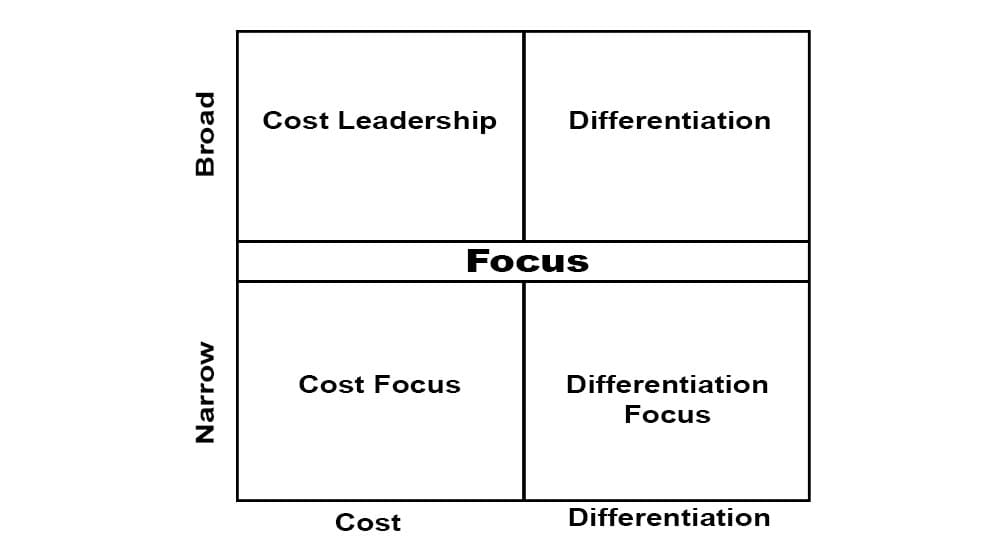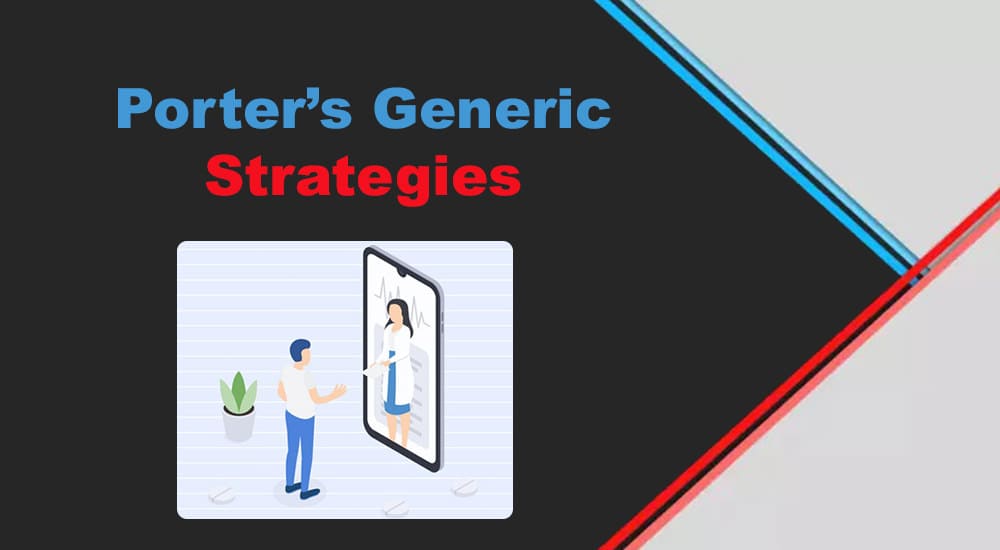Porter’s Generic Strategies were developed in 1985 by Michael Porter, and they first appeared in his book “Competitive Advantage: Creating and Sustaining Superior Performance.”
These strategies help businesses assess their growth, management, and profitability and create a competitive advantage.
What are Porter’s Generic Strategies?
Porter’s Generic Strategies include three approaches applied to all products or services.

- Cost Leadership Strategy
- Differentiation Strategy
- Focus Strategy
#1- Cost Leadership Strategy
The cost leadership approach aims to increase profits with reduced costs.
This strategy focuses on having a competitive advantage over other companies by keeping operating costs to a minimum. Businesses who wish to become the lowest-cost producers (even lower than the industry average) and grab the highest market share use this strategy.
To apply this strategy, businesses target a market with extensive demand and offer their products at the lowest price. When consumers notice their increased purchasing power, they might shift from the competitors.
If a business can offer the same quality products or services at a cheaper rate, it can become the market leader.
Walmart has used this strategy to grow its business. Walmart has the most efficient production process in the industry. They have built one of the largest distribution networks globally, which lets them sell their products at lower prices than competitors.
For example, a standard toaster oven available at 40 USD in Walmart can be seen at over 42 USD at Target.
McDonald’s, Primark, and IKEA are a few other examples of companies successfully employing the Cost Leadership Strategy in their businesses.
Questions to Consider Before Applying the Cost Leadership Strategy
- Where do the business’s competitors stand, and at what cost?
- Do the low prices align well with the business’s scalability?
- Will the cost-cutting have any impact on employees?
- Will the customers receive any part of the savings as discounts/benefits?
- How does the business plan to produce the lowest cost products or services?
- Will the business maintain profitability, growth, and sustainability with the lowest costs?
- Is the business in an industry where the competitors can easily copy the Cost Leadership Strategy?
Advantages of the Cost Leadership Strategy
- Being the lowest price, customers’ power does not affect business.
- Rigid barriers for new entrants due to the advantage held by the cost leader.
- The economy of scale due to low prices provides the company with a strong advantage over other powerful suppliers.
#2- Differentiation Strategy
The differentiation approach aims to create unique products and services.
This strategy focuses on developing unique and differentiated products or services not offered by competitors. Organizations that wish to lead the market with a unique product at higher prices use this strategy. The higher price points result in higher margins.
Companies can differentiate their product or service by enhancing their functionality, improving their taste, expanding their durability, etc.
To apply this strategy, businesses target an audience with high net worth. When customers feel that they are being offered a product that no other brand offers, they pay higher prices without hesitation.
Apple is the most prominent example of using a differentiation strategy. Over the years, Apple has created a niche market using differentiated products. Their products are unique, offer the best quality, and the price is the highest in the market.
For example, the average price of smartphones in the US is around 200 USD. In contrast, Apple’s iPhone retails at around 700 USD, which is more than three times the average price.
Questions to Consider Before Applying the Product Differentiation Strategy
- What does the business want to be known for?
- In which areas can the business develop a USP?
- What does the competitor’s innovation history suggest?
- What is the average industry rate of the product or service offered?
- Which niche market is the business targeting?
Advantages of the Product Differentiation Strategy
- It helps businesses create brand loyalty and bolsters customer repetition.
- The business can generate high margins due to the high prices.
- The unique features help a business defend their high prices and lead to non-price competition.
#3- Focus Strategy
The last approach is the focus approach, which aims to offer a unique product or service in a niche market. This approach is further divided into two parts – the Cost Focus and the Cost Differentiation approach.
Cost Focus
The Cost Focus Strategy targets a restricted market by charging relatively lower prices than its competitors. The point to be noted here is that businesses employing the Cost Focus Strategy does not charge the lowest price in the industry, but try to charge the lowest price offered within the particular target market.
Here, businesses focus on building a brand with simple products and decent profits. Since the business solely focuses on providing the utmost value to its customers, it is known as a niche marketing strategy. They improve financial efficiency and reduce operational costs to as much an extent as possible to have a profit margin that helps the business flourish even when prices are low.
McDonald’s is an example of this strategy. McDonald’s has employed the Cost Focus Strategy by offering fast food to the niche target customers who enjoy burgers and fries (mostly) at comparatively lower prices than their competitors.
The company manages its costs by training new recruits instead of hiring expensive and experienced cooks. Since it offers food at a low rate, fast-food lovers who want affordable meals are attracted to the chain, increasing McDonald’s sales. McDonald’s serves a cheeseburger at only 1 USD, whereas its biggest competitor, Burger King, serves its cheapest cheeseburger at around 1.39 USD.
Questions to Consider Before Applying the Cost Focus Strategy
- Is it possible for the business to provide the product or service at a lower rate?
- Where will the business be required to cut costs?
- How does the business plan to cut costs?
- How much would it cost per customer to become the niche market leader?
- Will the business be able to maintain quality after lowering the prices?
- What is the size of the niche market you are targeting?
Advantages of the Cost Focus Strategy
- The strategy builds brand loyalty by becoming the most affordable product or service provider.
- It allows businesses to stock raw materials in larger quantities.
- It enables businesses to get into franchising as the brand starts gaining recognition.
Cost Differentiation
This strategy aims to surpass rivals by offering a superior or customized product or service even after high pricing. This strategy focuses on a strong but narrow market coverage to attract small, specialized, and niche market segments.
Businesses make their products or services more attractive through better functionality, durability, robust support, and heavy brand marketing. This strategy helps improve profits, reduce risks and create a brand image by creating a unique and customized offering for a small audience.
To apply this strategy, businesses must stick to a particular differentiation that sets their product or service apart from the competition. The products or services should be offered in a niche market segment where customers prefer quality over quantity and are ready to pay more for a better experience.
Breeze Resorts in the Bahamas use this strategy successfully. They serve couples without children. Even though the prices are high compared to other properties in the area, their USP enables them to attract customers who wish to enjoy their vacations in a children-free zone. The audience is “couples without children.”
Questions to Consider Before Applying the Differentiation Focus Strategy
- Is the audience size large enough for the business to sustain?
- What new features can be added to apply the strategy?
- How have the other businesses priced themselves in the market?
- Is there any perfect product or service substitutes within the target market?
Advantages of the Differentiation Focus Strategy
- This strategy allows businesses higher profit margins as they can sell for higher prices.
- The strategy leads to non-price competition due to the unique offerings.
- Such businesses can easily add auxiliary products by adding additional services to the existing portfolio.
Step-Wise Guide: How to Choose the Right Porter’s Generic Strategy
Step 1
Conduct thorough research about competitors in the industry. Analyze how the businesses have remained competitive in the market. Create a competitive analysis document to find ways to stay at the top. This document must always be updated.
Step 2
Conduct a SWOT Analysis for businesses to understand the strengths, weaknesses, opportunities, and threats. This ensures that the business uses the right strategy according to its strengths and weaknesses.
Step 3
Conduct Porter’s Five Forces Analysis to get an idea about the competitive environment. This will provide businesses with potential market entrants, suppliers, the influence of substitutes on profitability, potential customers, rival competitive powers, and more.
Step 4
Compare the Porter’s Five Forces Analysis with the SWOT Analysis to narrow down strategy options. For each option, consider how the strategy helps manage:
- Competitive rivalry
- The threat of new entrants
- Substitution threat
- Supplier power
- Buyer or customer price making power
Whichever Porter’s Generic Strategy gives the business the strongest set of options to succeed in the market shall be chosen.
Conclusion
Porter’s Generic Strategies help assist in a business’ competitive analysis. They also act as an incredible strategy decision-making pedestal, which businesses can use to endure and grow in the market. When businesses employ these strategies, it becomes easier for them to work towards their goals and flourish through the essence of exclusivity.
